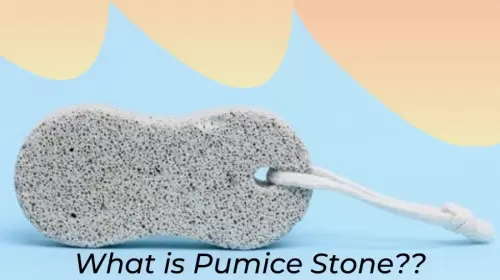Table of Content
A pumice stone forms when lava and water mix. It is a light but abrasive stone used to remove dry and dead skin. A pumice stone can also soften calluses and corns to reduce friction pain.
You can use this pumice stone on a daily basis, but it is important to know how to use it correctly. If you're not careful, you could remove too much skin, cause bleeding, or increase your risk of infection.

Supplies
You can buy a pumice stone at your local beauty supply store or grocery store. Some stores offer a double-sided pumice stone. These stones have an abrasive side for rough skin and a softer side for more sensitive or polished areas.
To safely exfoliate your skin, you will also need a large bowl or basin of warm, soapy water. This is especially important for exfoliating your feet or hands. If you want to use a pumice stone on your elbows, face, or neck, consider wearing this pumice stone while showering.
Other accessories you need including
- soft towel
- Moisturizer (cream, lotion, or oil)
- moisturizing socks (optional)
- Bristle brush for cleaning pumice stone

Step by step instructions:
These instructions will help you remove rough skin properly. If you begin to have pain or irregular symptoms, stop using the pumice stone immediately.
Preparation
- Gather all your supplies in one place. Make sure the stone and water are clean.
- Soak your dry, callused skin in warm water for 5 to 10 minutes. This will help soften the hardened skin. Add soap or oil to the water for extra softness and increased moisture. If you are using a pumice stone on your elbows, knees, or face, complete this step in a warm bath or shower.
Using the pumice stone
- While your skin is soaking, soak a pumice stone in warm water. Never use a dry pumice stone on your skin. A wet pumice stone glides easily across your skin and reduces the risk of infection.
- Remove the targeted area from the soap bath and pat dry with a towel. If your skin is still rough, soak it for a few more minutes before patting your skin to dry.
- Remove the pumice stone from the warm water and apply it to your skin.
- Rub the abrasive side of the pumice stone onto your skin in a circular motion with light pressure. Massage your skin for two to three minutes. If your skin begins to ache or ache, stop immediately because you are probably applying too much pressure.

- For feet, focus your attention on the heels, the sides of the toes, and other dry areas that you are familiar with.
- Keep rubbing the pumice stone on your skin until you remove the dead skin and reveal softer skin underneath.
- Rinse your skin after two to three minutes of light scrubbing. If patches of dead skin still appear, repeat the process. Also, rinse the pumice stone with each session to keep the surface clean.
- You can repeat this process daily or several times a week to keep your skin soft and supple.
Also, Read - Face Serums can work wonders for your skin. How?
Finishing up
- When you're done, apply a moisturizer or oil to your skin to lock in moisture and keep your skin smooth. For a boost, wear hydrating socks after moisturizing your skin.
- Clean the pumice stone after each use. Under running water, use a brush to remove dead skin from the stone. Apply a small amount of soap to make sure it is clean and free of dirt. Bacteria can grow on the surface.
- Do not share a pumice stone with other people. Each family member should have their own.
- Let the stone dry on its own. Place it in a dry area away from moisture to avoid bacterial growth.
- For a deep clean, boil a pumice stone in hot water for five minutes. Allow it to air dry, away from damp areas.
- Your stone will wear out over time, and become too smooth to remain effective. If your stone becomes too small, smooth, or soft, replace it.
Tips for using a pumice stone
For your face and neck
Your face and neck are the most sensitive areas. Excessive pressure may lead to redness and abrasions. To use a pumice stone on your face or neck, consider purchasing a double-sided stone.
Repeat the same steps above. Instead of using the abrasive side of a pumice stone, use the softer side. Rub the stone in a circular motion for 15 seconds. If you notice redness or burning, stop using the pumice stone immediately.
After exfoliating your skin, rinse your face and neck with warm water and apply moisturizer. Just use a pumice stone on your face once a week.

Also Read - India's Best Trimmer for Men [August 2021] - Buying Guide, Price, Availability, and Features
Hair removal
In addition to removing dead skin, a pumice stone can also remove unwanted hair.
You can follow these steps to
- Soften your skin with warm water for 5-10 minutes.
- Moisten the pumice stone.
- Apply soap to the skin.
- Apply a pumice stone to your skin, and rub it in a circular motion with gentle pressure to remove the hair.

- Rinse and repeat the process until the hair is completely removed. If you notice any irritation, stop using the pumice stone immediately.
- When finished, rinse well with warm water to remove excess hair or skin.
- Apply a moisturizer or oil to your skin.
- Repeat this process every few days until the hair is completely removed.
Pumice stone aftercare
These instructions should guide you through the safe and effective use of a pumice stone for waxing or exfoliation. After using a pumice stone, always moisturize your skin and clean the stone. Remember that your results may not reflect someone else's results.
If you begin to feel any irritation or pain, stop using this stone immediately. People with sensitive skin may not be able to use a pumice stone. If your skin tears during this process, use an antiseptic and stop using it. Discuss other options with your doctor or dermatologist.
Also, Read - All you need to know about rice water for hair...
.webp)





_1735214375.webp)







